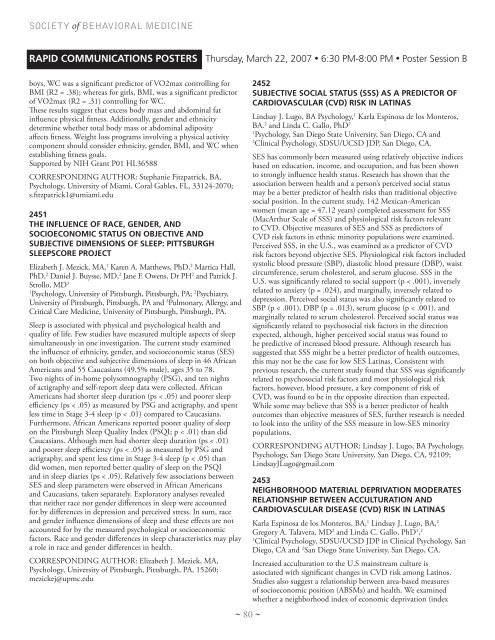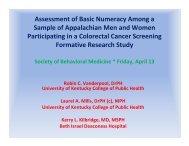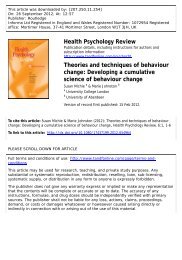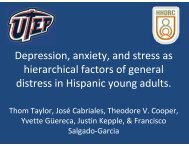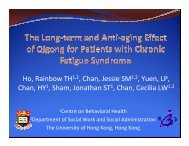2007 Final Program - Society of Behavioral Medicine
2007 Final Program - Society of Behavioral Medicine
2007 Final Program - Society of Behavioral Medicine
Create successful ePaper yourself
Turn your PDF publications into a flip-book with our unique Google optimized e-Paper software.
SOCIETY <strong>of</strong> BEHAVIORAL MEDICINE<br />
Rapid Communications Posters Thursday, March 22, <strong>2007</strong> • 6:30 PM-8:00 PM • Poster Session B<br />
boys, WC was a significant predictor <strong>of</strong> VO2max controlling for<br />
BMI (R2 = .38); whereas for girls, BMI, was a significant predictor<br />
<strong>of</strong> VO2max (R2 = .31) controlling for WC.<br />
These results suggest that excess body mass and abdominal fat<br />
influence physical fitness. Additionally, gender and ethnicity<br />
determine whether total body mass or abdominal adiposity<br />
affects fitness. Weight loss programs involving a physical activity<br />
component should consider ethnicity, gender, BMI, and WC when<br />
establishing fitness goals.<br />
Supported by NIH Grant P01 HL36588<br />
CORRESPONDING AUTHOR: Stephanie Fitzpatrick, BA,<br />
Psychology, University <strong>of</strong> Miami, Coral Gables, FL, 33124-2070;<br />
s.fitzpatrick1@umiami.edu<br />
2451<br />
THE INFLUENCE OF RACE, GENDER, AND<br />
SOCIOECONOMIC STATUS ON OBJECTIVE AND<br />
SUBJECTIVE DIMENSIONS OF SLEEP: PITTSBURGH<br />
SLEEPSCORE PROJECT<br />
Elizabeth J. Mezick, MA, 1 Karen A. Matthews, PhD, 2 Martica Hall,<br />
PhD, 2 Daniel J. Buysse, MD, 2 Jane F. Owens, Dr PH 2 and Patrick J.<br />
Strollo, MD 3<br />
1<br />
Psychology, University <strong>of</strong> Pittsburgh, Pittsburgh, PA; 2 Psychiatry,<br />
University <strong>of</strong> Pittsburgh, Pittsburgh, PA and 3 Pulmonary, Allergy, and<br />
Critical Care <strong>Medicine</strong>, University <strong>of</strong> Pittsburgh, Pittsburgh, PA.<br />
Sleep is associated with physical and psychological health and<br />
quality <strong>of</strong> life. Few studies have measured multiple aspects <strong>of</strong> sleep<br />
simultaneously in one investigation. The current study examined<br />
the influence <strong>of</strong> ethnicity, gender, and socioeconomic status (SES)<br />
on both objective and subjective dimensions <strong>of</strong> sleep in 46 African<br />
Americans and 55 Caucasians (49.5% male), ages 35 to 78.<br />
Two nights <strong>of</strong> in-home polysomnography (PSG), and ten nights<br />
<strong>of</strong> actigraphy and self-report sleep data were collected. African<br />
Americans had shorter sleep duration (ps < .05) and poorer sleep<br />
efficiency (ps < .05) as measured by PSG and actigraphy, and spent<br />
less time in Stage 3-4 sleep (p < .01) compared to Caucasians.<br />
Furthermore, African Americans reported poorer quality <strong>of</strong> sleep<br />
on the Pittsburgh Sleep Quality Index (PSQI; p < .01) than did<br />
Caucasians. Although men had shorter sleep duration (ps < .01)<br />
and poorer sleep efficiency (ps < .05) as measured by PSG and<br />
actigraphy, and spent less time in Stage 3-4 sleep (p < .05) than<br />
did women, men reported better quality <strong>of</strong> sleep on the PSQI<br />
and in sleep diaries (ps < .05). Relatively few associations between<br />
SES and sleep parameters were observed in African Americans<br />
and Caucasians, taken separately. Exploratory analyses revealed<br />
that neither race nor gender differences in sleep were accounted<br />
for by differences in depression and perceived stress. In sum, race<br />
and gender influence dimensions <strong>of</strong> sleep and these effects are not<br />
accounted for by the measured psychological or socioeconomic<br />
factors. Race and gender differences in sleep characteristics may play<br />
a role in race and gender differences in health.<br />
CORRESPONDING AUTHOR: Elizabeth J. Mezick, MA,<br />
Psychology, University <strong>of</strong> Pittsburgh, Pittsburgh, PA, 15260;<br />
mezickej@upmc.edu<br />
~ 80 ~<br />
2452<br />
SUBJECTIVE SOCIAL STATUS (SSS) AS A PREDICTOR OF<br />
CARDIOVASCULAR (CVD) RISK IN LATINAS<br />
Lindsay J. Lugo, BA Psychology, 1 Karla Espinosa de los Monteros,<br />
BA. 2 and Linda C. Gallo, PhD 2<br />
1<br />
Psychology, San Diego State University, San Diego, CA and<br />
2<br />
Clinical Psychology, SDSU/UCSD JDP, San Diego, CA.<br />
SES has commonly been measured using relatively objective indices<br />
based on education, income, and occupation, and has been shown<br />
to strongly influence health status. Research has shown that the<br />
association between health and a person’s perceived social status<br />
may be a better predictor <strong>of</strong> health risks than traditional objective<br />
social position. In the current study, 142 Mexican-American<br />
women (mean age = 47.12 years) completed assessment for SSS<br />
(MacArthur Scale <strong>of</strong> SSS) and physiological risk factors relevant<br />
to CVD. Objective measures <strong>of</strong> SES and SSS as predictors <strong>of</strong><br />
CVD risk factors in ethnic minority populations were examined.<br />
Perceived SSS, in the U.S., was examined as a predictor <strong>of</strong> CVD<br />
risk factors beyond objective SES. Physiological risk factors included<br />
systolic blood pressure (SBP), diastolic blood pressure (DBP), waist<br />
circumference, serum cholesterol, and serum glucose. SSS in the<br />
U.S. was significantly related to social support (p < .001), inversely<br />
related to anxiety (p = .024), and marginally, inversely related to<br />
depression. Perceived social status was also significantly related to<br />
SBP (p < .001), DBP (p = .013), serum glucose (p < .001), and<br />
marginally related to serum cholesterol. Perceived social status was<br />
significantly related to psychosocial risk factors in the direction<br />
expected, although, higher perceived social status was found to<br />
be predictive <strong>of</strong> increased blood pressure. Although research has<br />
suggested that SSS might be a better predictor <strong>of</strong> health outcomes,<br />
this may not be the case for low SES Latinas. Consistent with<br />
previous research, the current study found that SSS was significantly<br />
related to psychosocial risk factors and most physiological risk<br />
factors, however, blood pressure, a key component <strong>of</strong> risk <strong>of</strong><br />
CVD, was found to be in the opposite direction than expected.<br />
While some may believe that SSS is a better predictor <strong>of</strong> health<br />
outcomes than objective measures <strong>of</strong> SES, further research is needed<br />
to look into the utility <strong>of</strong> the SSS measure in low-SES minority<br />
populations.<br />
CORRESPONDING AUTHOR: Lindsay J. Lugo, BA Psychology,<br />
Psychology, San Diego State University, San Diego, CA, 92109;<br />
LindsayJLugo@gmail.com<br />
2453<br />
NEIGHBORHOOD MATERIAL DEPRIVATION MODERATES<br />
RELATIONSHIP BETWEEN ACCULTURATION AND<br />
CARDIOVASCULAR DISEASE (CVD) RISK IN LATINAS<br />
Karla Espinosa de los Monteros, BA, 1 Lindsay J. Lugo, BA, 2<br />
Gregory A. Talavera, MD 2 and Linda C. Gallo, PhD 1 , 2<br />
1<br />
Clinical Psychology, SDSU/UCSD JDP in Clinical Psychology, San<br />
Diego, CA and 2 San Diego State Univeristy, San Diego, CA.<br />
Increased acculturation to the U.S mainstream culture is<br />
associated with significant changes in CVD risk among Latinos.<br />
Studies also suggest a relationship between area-based measures<br />
<strong>of</strong> socioeconomic position (ABSMs) and health. We examined<br />
whether a neighborhood index <strong>of</strong> economic deprivation (index


